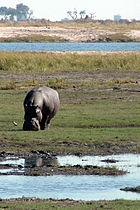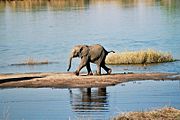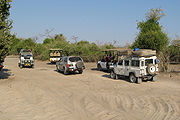
Chobe National Park
Background to the schools Wikipedia
This wikipedia selection has been chosen by volunteers helping SOS Children from Wikipedia for this Wikipedia Selection for schools. Before you decide about sponsoring a child, why not learn about different sponsorship charities first?
| Chobe National Park | |
|---|---|
|
IUCN category II ( national park)
|
|
| Location | Botswana |
| Nearest city | Kasane |
| Coordinates | 18°40′S 24°30′E Coordinates: 18°40′S 24°30′E |
| Area | 11,700km² |
| Established | 1967 |
Chobe National Park, in northwest Botswana, has one of the largest concentrations of game in Africa. By size, it is the third largest park of the country, after the Central Kalahari Game Reserve and the Gemsbok National Park, and is the most diverse. It is also the country's first national park.
Geography and ecosystems
The park can be divided up to 4 areas, each corresponding to one distinct ecosystem:
- The Serondela area (or Chobe riverfront), situated in the extreme Northeast of the park, has as its main geographical features lush floodplains and dense woodland of mahogany, teak and other hardwoods now largely reduced by heavy elephant pressure. The Chobe, which flows along the Northeast border of the park, is a major watering spot, especially in the dry season (May through October) for large breeding herds of elephants, as well as families of giraffe, sable and cape buffalo. The flood plains are the only place in Botswana where the puku antelope can be seen. Birding is also excellent here. Large numbers of carmine bee eaters are spotted in season. When in flood spoonbills, ibis, various species of stork, duck and other waterfowl flock to the area. This is probably the most visited park section, partly because of its proximity to the Victoria Falls. The town of Kasane, situated just downstream, is the most important town of the region and serves as northern entrance to the park.
- The Savuti Marsh area, 10 878 km² large, constitutes the western stretch of the park (50 km north of Mababe Gate). The Savuti Marsh is the relic of a large inland lake whose water supply was cut a long time ago by tectonic movements. Nowadays the marsh is fed by the erratic Savuti Channel, which dries up for long periods then curiously flows again, a consequence of tectonic activity in the area. It is currently flowing again and in January 2010 reached Savuti Marsh for the first time since 1982. As a result of this variable flow, there are hundred of dead trees along the channel's bank. The region is also covered with extensive savannahs and rolling grasslands, which makes wildlife particularly dynamic in this section of the park. At dry seasons, tourists going on safari often view warthogs, kudus, impalas, zebras, wildebeests and above all elephants bullying each other. At rain seasons, the rich birdlife of the park (450 species in the whole park) is well represented. Packs of lions, hyenas, zebras or more rarely cheetahs are visible as well. This region is indeed reputed for its annual migration of zebras and predators.
- The Linyanti Marsh, located at the Northwest corner of the park and to the North of Savuti, is adjacent to Linyanti River. To the west of this area lies Selinda Reserve and on the Northern bank of Kwando River is Namibia's Mamili National Park. Around these 2 rivers are riverine woodlands, open woodlands as well as lagoons, and the rest of the region mainly consists of flood plains. There are here large concentrations of lions, leopards, wild dogs, Roan antelopes, Sable antelopes, hippopotamuses and above all enormous herds of elephants. The rarer red lechwe, sitatunga or crocodile also occur in the area. Birdlife is very rich here.
- Between Linyanti and Savuti Marshes lies a hot and dry hinterland, mainly occupied by the Nogatsaa grass woodland. This section is little known and is a great place for spotting elands.
Park history
The original inhabitants of this area were the San bushmen (also known as the Basarwa people in Botswana). They were nomadic hunter-gatherers who were constantly moving from place to place to find food sources, namely fruits, water and wild animals. Nowadays one can find San paintings inside rocky hills of the park.
At the beginning of the 20th century, the region that would become Botswana was divided up to different land tenure systems. At that time, a major part of the park's area was classified as crown land. The idea of a national park to protect the varied wildlife found here as well as promote tourism first appeared in 1931. The following year, 24'000 km² around Chobe district were officially declared non-hunting area; this area was expanded to 31'600 km² two years later.
In 1943, heavy tsetse infestations occur throughout the region, making the idea of creating a national park momentarily left aside. It was only in 1953 that this project received governmental attention again: 21'000 km² were suggested to become a game reserve. As a result, the Chobe Game Reserve was born in 1960 with an area smaller than originally wanted. Finally, in 1967, the reserve was declared a national park.
At that time there were several industrial settlements in the region, especially at Serondela, where the timber industry proliferated. These settlements were gradually moved out of the park, and it was not until 1975 that the whole protected area was exempt from human activity. Nowadays traces of the old timber industry are still visible at Serondela. Minor expansions of the park took place in 1980 and 1987.
Elephant concentration
The park is probably best known for its spectacular elephant population: It contains an estimated 50,000 elephants, perhaps the highest elephant concentration of Africa, and part of the largest continuous surviving elephant population. The elephant population seems to have solidly built up since 1990, from a few thousand.
Elephants living here are Kalahari elephants, the largest in size of all known elephant populations. They are characterized by rather brittle ivory and short tusks, perhaps due to calcium deficiency in the soils.
Damage caused by the high numbers of elephants is rife in some areas. In fact, concentration is so high throughout Chobe that culls have been considered, but are too controversial and have thus far been rejected.
At dry season, these elephants sojourn in Chobe River and the Linyanti River areas. At rain season, they make a 200-km migration to the southeast stretch of the park. Their distribution zone however outreaches the park and spreads to northwestern Zimbabwe.
Tourist facilities
There are three main camping sites within the park, all of which are equipped with shower-toilets facilities and require booking in advance:
- The newest one at Ihaha was built in order to replace the closed one at Serondela. This camping site is also more remote in nature comparatively to the former one at Serondela.
- At Savuti, 172 km southwest of Sedudu Gate. This camping ground overlooks the Savuti Channel.
- The Linyanti has a number of private concessions where Luxury Camps has been built.
- A smaller camping ground can be found at Linyanti, lying at 39 km Northwest of Savuti. The camping ground here overlooks the Linyanti River so there are many chances of seeing and hearing hippos in the river. Off the beaten tracks, the Linyanti camp is much quieter than the previously described ones. There is an ablution block with toilets and showers, and a boiler to heat water.
- Chobe Game Lodge is the only permanent lodge in the park. Luxury tourist accommodation is also available in Savute.
4-wheel vehicles are usually used for transfer between camps, as the road network here is recent and relatively primitive. The road is best near the Chobe River. However it exists no facility between Maun and Kasane. Therefore it is always safe for tourists to carry with them basic items such as food, water or tools.
This park is considered for inclusion in the 5 Nation Kavango - Zambezi Transfrontier Conservation Area.





